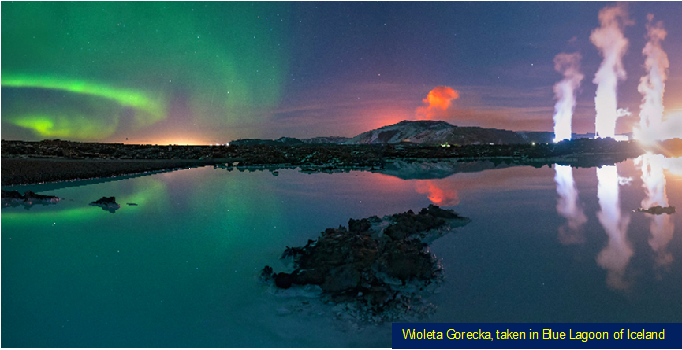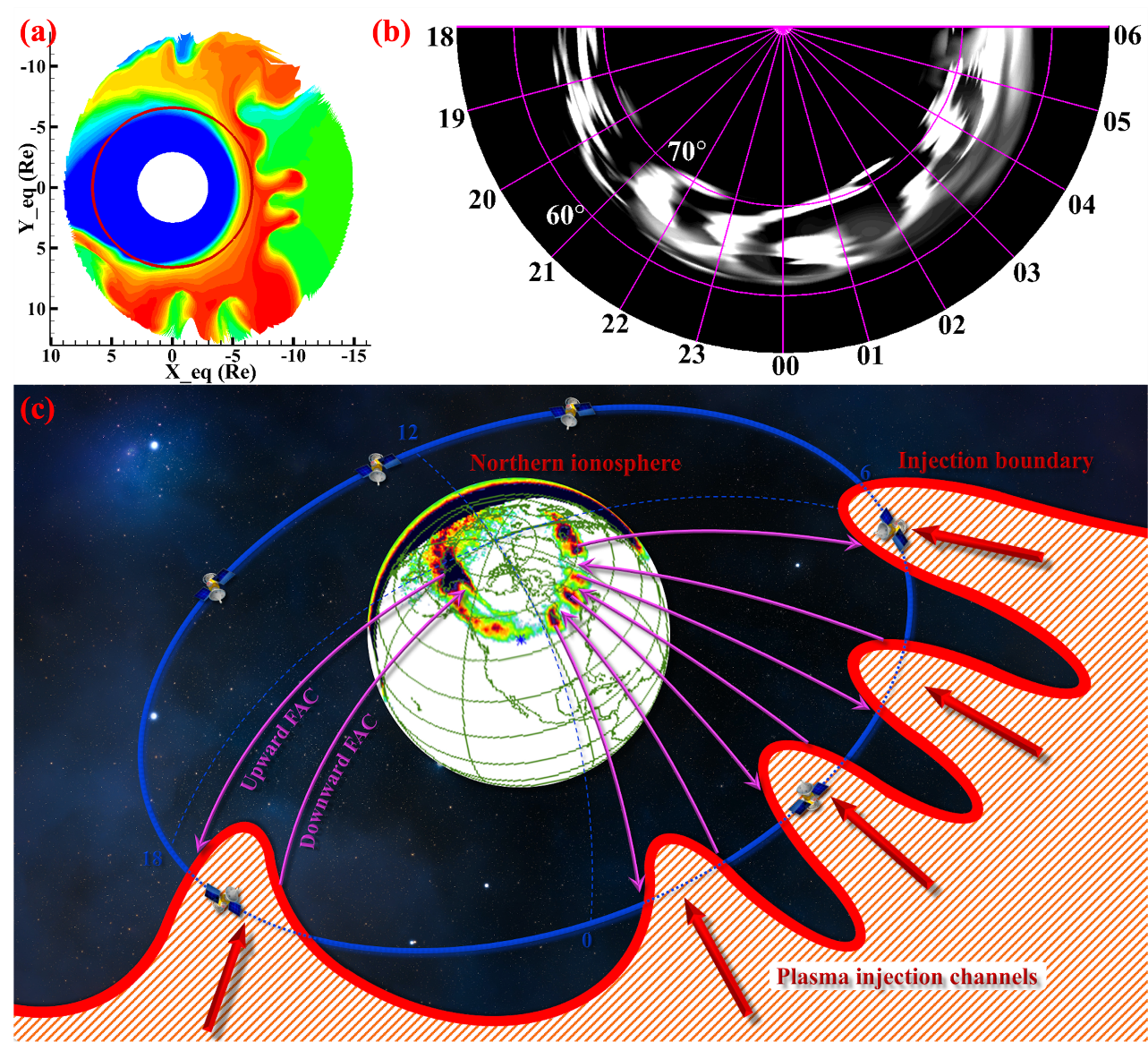Recent advances in understanding magnetospheric source of aurora
Dong WEI & Jian YANG 2021-11-17
Aurora, also known as northern lights or southern lights, is a natural light display in the Earth’s sky, predominantly seen in high-latitude regions. The colorful auroras appear in a variety of continuously changing shapes.
The typical aurora is caused by collisions between fast-moving energetic particles coming from the Earth’s magnetosphere or the Sun’s surface and the oxygen and nitrogen in the Earth’s upper atmosphere (altitude of 100 to 300 km). Therefore, the research on aurora’s formation mechanisms with different morphologies plays a crucial role in understanding the near-Earth space environment.
Associate Professor Jian Yang’s group from the Department of Earth and Space Sciences at the Southern University of Science and Technology (SUSTech) and Professor Jun Cui’s group from the School of Atmospheric Sciences at Sun Yat-sen University have recently made a series of significant progress on the auroral research. Their resulting three papers have been published in Geophysical Research Letters, a leading Natural Index journal in the field of Earth Sciences.

What is the magnetospheric driver of westward traveling surge?
The auroral substorm is a sequence of characteristics of auroral motions and geomagnetic perturbations. Following the substorm onset, the aurora intensifies and expands poleward. The poleward expansion of the aurora leads to a bulge that then expands westward, forming a particular structure which is referred to as a westward traveling surge (WTS). However, there has so far been little discussion of what drives the WTS in the magnetosphere.
 Figure 1. The aurora in the high-latitude region of the Earth (Green lights on the left)
Figure 1. The aurora in the high-latitude region of the Earth (Green lights on the left)
This study investigates the generation mechanism of the WTS using numerical simulations of the Rice Convection Model and auroral observations in the ionosphere. The simulated characteristics of the WTS are consistent with typical observed features of the WTS. It also suggests that the plasma-sheet bubble is the magnetospheric source of the WTS.
This research paper is entitled “A Magnetospheric Driver of Westward Traveling Surge: Plasma-Sheet Bubble.” Dr. Dong Wei, a postdoctoral researcher at SUSTech, is the first author of this paper. Prof. Jian Yang is the corresponding author.
 Figure 2. (a) The simulated WTS; (b) Schematics of the magnetospheric driver of the WTS.
Figure 2. (a) The simulated WTS; (b) Schematics of the magnetospheric driver of the WTS.
What is the magnetospheric source of the intense Subauroral Ion Drifts?
Strong Thermal Emission Velocity Enhancement (STEVE), a narrow purple band of light that manifests southward of the auroral oval, has been documented by amateur sky-watchers for decades. Despite the STEVE often coming together with the aurora, it appears distinctly different from traditional auroral structures.
Statistical studies have shown that STEVE is associated with intense and long-lasting Subauroral Ion Drifts (SAIDs) in the ionosphere. However, how the STEVEs are formed and what the connection is between STEVE and SAIDs remain unclear.
In this study, Prof. Yang’s group used the Rice Convection Model to simulate a substorm event by specifying consecutive plasma injections accompanied by the STEVE phenomenon. The simulation results reproduced key features of intense SAIDs. They suggested that the multiple plasma-sheet bubble injections into the inner magnetosphere play an important role in the formations of SAIDs and STEVE.
This research paper is entitled “Magnetospheric source and electric current system associated with intense SAIDs.” Dr. Wenrui Wang, a research scientist at Sun Yat-sen University and a visiting scholar at SUSTech, is the first author of this paper. Prof. Jian Yang is the corresponding author.
 Figure 3. (a) STEVE in the sky; (b)-(c) The simulation results of a SAID event.
Figure 3. (a) STEVE in the sky; (b)-(c) The simulation results of a SAID event.
What causes spatially periodic finger-like auroras during a sawtooth substorm event?
Sawtooth substorm events are identified as recurrent substorm injections, characterized by a series of sudden enhancement, followed by a gradual decrease in energetic particle flux profiles that resemble the teeth of a saw blade.
Previous observational and numerical studies focused on the temporal periodicity of sawtooth events. However, Prof. Yang’s team found that the particle injections in the magnetosphere and the evolution of auroral morphologies in the ionosphere during a sawtooth substorm event are significantly different from that in an ordinary substorm event.
In this study, they combined the numerical simulation of the Rice Convection Model with the satellites data to investigate how the injection develops and couples with the ionosphere during a sawtooth substorm. They found the wide injection breaks up into multiple injection channels, which are nearly one-to-one co-located with multiple finger-like auroral structures.
Their study provides strong evidence that interchange instability plays a central role in the development of multiple injection channels.
This research paper is entitled “Development of Multiple Injection Channels During a Sawtooth Substorm Event.” Mr. Weiqin Sun, a Ph.D. student at Sun Yat-sen University and a visiting student at SUSTech, is the first author of this paper. Prof. Jian Yang is the corresponding author.
 Figure 4. (a)-(b) The simulation results of a sawtooth event; (c) Schematics of the magnetosphere-ionosphere coupling process.
Figure 4. (a)-(b) The simulation results of a sawtooth event; (c) Schematics of the magnetosphere-ionosphere coupling process.
Apart from the three papers mentioned above, Prof. Jian Yang’s group has also published two additional papers in Geophysical Research Letters in 2021.
They also investigated the effects of the violation of frozen-in flux conditions by assuming ions slip with respect to the magnetic field lines in the late substorm growth phase while electrons remain magnetized.
The paper is entitled “Effects of Ion Slippage in Earth’s Ionosphere and the Plasma Sheet”. Dr. Wenrui Wang is the first author, and Jian Yang is the corresponding author.
Another study provided a new method that combined the ionospheric energetic proton flux and energetic electron loss-cone filling rate to detect a rapid traversal from stretched to dipolarized field lines across the flow channel.
The paper is entitled “Manifestations of Magnetotail Flow Channels in Energetic Particle Signatures at Low-Altitude Orbit”. Mr. Weiqin Sun is the second author, and Jian Yang is the third author of this paper.
These works were supported financially by the National Natural Science Foundation of China (NSFC), the Strategic Priority Research Program of the Chinese Academy of Sciences, and the Stable Support Plan Program of Shenzhen Natural Science Fund.
Paper links:
A Magnetospheric Driver of Westward Traveling Surge: Plasma-Sheet Bubble:
https://agupubs.onlinelibrary.wiley.com/doi/10.1029/2021GL095539
Magnetospheric source and electric current system associated with intense SAIDs:
https://agupubs.onlinelibrary.wiley.com/doi/10.1029/2021GL093253
Development of Multiple Injection Channels During a Sawtooth Substorm Event:
https://agupubs.onlinelibrary.wiley.com/doi/10.1029/2021GL094097
Effects of Ion Slippage in Earth’s Ionosphere and the Plasma Sheet:
https://agupubs.onlinelibrary.wiley.com/doi/10.1029/2020GL091494
Manifestations of Magnetotail Flow Channels in Energetic Particle Signatures at Low-Altitude Orbit:
https://agupubs.onlinelibrary.wiley.com/doi/10.1029/2021GL093543




